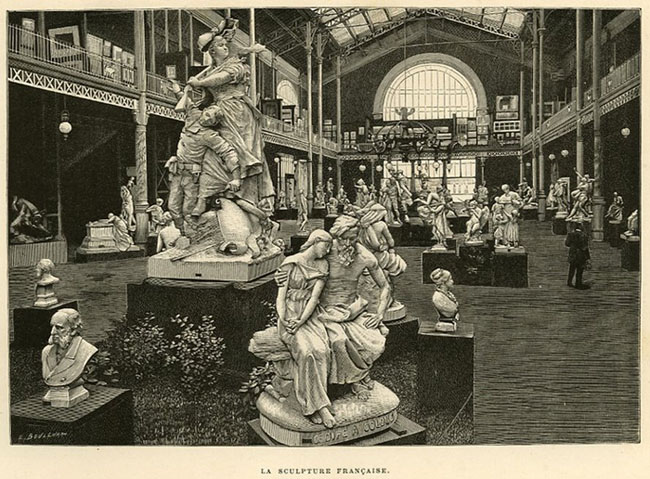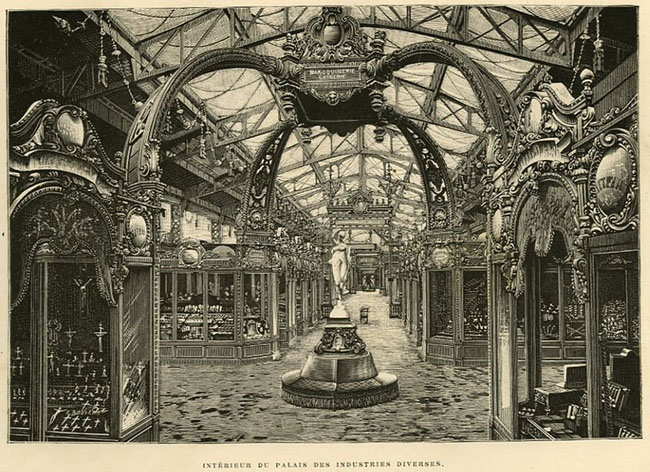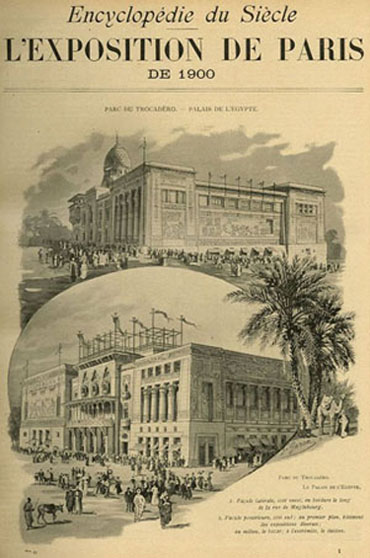World's Fairs
Download PDFThe French wanted to exhibit and propagate their industrial artistry, demonstrate the strength of their economy and elate their national pride. National Fairs of industrial products were initiated during the Directoire period and regularly organized in Paris between 1798 and 1849. The first was held at the Champs de Mars and the second in 1801 in the Square Courtyard of the Louvre.
In 1849 the idea of organizing the first fair dedicated to industrial products of all nations emerged, with the idea of encouraging the arts, manufacturing and commerce. The United Kingdom, at the peak of its political and economic power, claimed to be representative of modernity and free market. Therefore the first “Great Exhibition of the Works of Industry of All Nations” was held in the Crystal Palace in Hyde Park, London from May 1st to October 10th, 1851. Thus the idea behind World’s Fairs was to present manufactured products from different nations, each participating nation competing to show their technological and industrial know-how. These fairs bear witness to the progress accomplished by the industrial Revolution of the 19th century. The competition was fierce and the best work received medals, which gave prestige to the company.
After this very successful first edition, Louis-Napoleon decided in 1852 to build a permanent exhibition centre in the Cours la Reine to house the 12th national manufactured products fair planned for 1854. However Napoleon III changed his mind and decreed that in 1855 the first Exposition Universelle des produits de l'Agriculture, de l'Industrie et des Beaux-Arts would be held there in 1855. The fair covered 39 acres; the Palace of Industry was the major building, the other main buildings being the Palace of Fine Arts and the Machine Gallery, which were linked by a round edifice. After the fair, only the Palace of Industry remained and served different functions until its destruction just before the World’s Fair of 1900.
Originally every country had a space reserved in the central pavilion. Starting in 1867, separate national pavilions were also built. At first the idea was to welcome extra countries that could not fit into the main palace, but the exhibiting nations liked the idea of building a pavilion typical of their culture.
The fourth fair was in Paris, the goal being to show France’s modernity thanks to the massive mechanization of production and a flourishing industrial development. The World’s Fair of 1867 reflects the apogee of the Second Empire, in a city transformed by the Baron Haussman’s plans under the instigation of Napoleon III. The parks of Montsouris and the Buttes Chaumont opened to the public. Comfort, leisure and luxury were the new ambition of Parisian society.
The World’s Fair of 1878, encouraged many remarkable urban transformations, new avenues were built, as was the Trocadero Palace, the widening of the Iena Bridge…
The most political of World’s Fairs in Paris was in 1889, the centennial of the French Revolution. The monuments and pavilions were tokens of Man’s creativity and progress; they honoured a new energy and material: electricity and iron. The most remarkable examples were the Machine Palace and the Eiffel Tower.
The quest for modernity and novelty continued in 1900, when the World’s Fair in Paris, glorified the Sciences and the Arts.
- Photo 1 : Crystal Palace, World's Fair of 1851 in London.
- Photo 2 : Inauguration World's Fair of 1855 in Paris, in presence of Napoleon III and Eugenie.
- Photo 3 : Side view from the river Seine of the World's Fair of 1867 in Paris, printed in the Monde Illustré.
- Photo 4 : Construction of the iron tower by Gustave Eiffel for the World's Fair of 1889.
- Photo 5 : "French sculpture", World's Fair of 1889 in Paris.
- Photo 6 : "Inside view of the Palace of diverse Industries, World's Fair of 1889.
- Photo 7 : World's Fair of 1900 in Paris, Trocadéro Palace and Palace of Egypt..

















